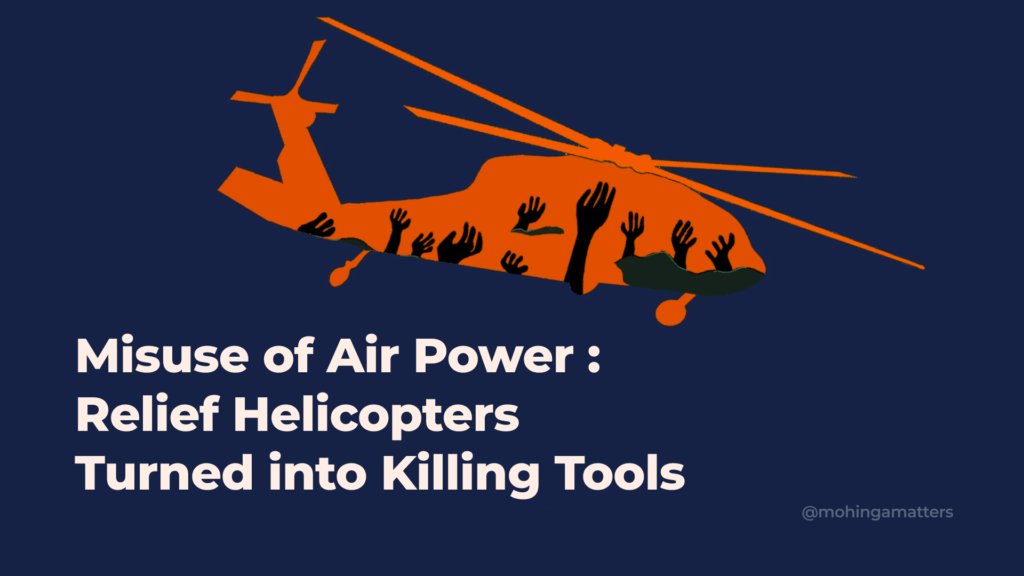
Myanmar citizens were surprised to see a flood rescue mission by the military. In their entire lives, they have witnessed such visuals only in movies: the Air Force’s helicopter buzzing around, providing aid and relief for civilians who suffered the most devastating flood in Southeast Asia’s history. On social media, Myanmar netizens cheered for security personnel from the army, navy, and air force who were actively involved in search and rescue missions, with videos circulating among Myanmar Facebook and TikTok users. Every Myanmar praised the uniformed personnel’s goodwill towards civilians, with comments on social media posts saying, “They (Thailand army) are so different from ours (Myanmar army).” Yes, it was Thailand’s Royal Armed Forces helping their people, not the Myanmar army.
While Thailand was helping its citizens, just a few kilometers away, the Myanmar army was committing war crimes. Instead of relief packages, flood and war victims from Myanmar were hit with explosive ordinances. Like Thailand, the Myanmar Air Force was busy, but not with search and rescue missions—instead, they were hunting and killing their own civilians.
The Myanmar Air Force had been upgraded during the Than Shwe regime under the claim of “growing the army to defend the country from colonialism”. Among Southeast Asian countries, the Myanmar Army is likely the only institution in the region that can manage the military budget on its own. In 2023, Min Aung Hlaing approved a military budget of around USD 2.7 billion for the 2023–2024 fiscal year. In the early 1990s, the Myanmar Army started a modernization plan for its Air Force, acquiring a wide range of fighter jets, radar, electronic warfare facilities, and helicopters. Reports suggest that the Myanmar Air Force has over 70 different helicopter models at its disposal. However, using them has been a privilege reserved even within the army’s inner circle. Before the 2021 Spring Revolution, there was a specific rank required to have access to helicopter travel. Helicopters served mainly as VVIP transport and were showcased in simulations and parades to please Min Aung Hlaing. From the 1990s to today, the Myanmar Air Force acquired Bell 205/206, Mil Mi-2, Mi-17, Mil Mi-35 gunships, and a Eurocopter (commissioned in 2019), despite an arms embargo.
Even though the Myanmar Air Force owns such a large number of helicopters, it has already proven ineffective in many humanitarian missions, such as during the Cyclone Nargis that devastated the Ayeyarwaddy Region in 2008. The Myanmar military helicopter pilots are trained only to transport VIP personnel and put on a show during Armed Forces Day, not to conduct humanitarian missions. Dr. Win Myat Aye, Minister for Humanitarian Affairs and Disaster Management of the National Unity Government, told Mohinga Matters, “(Helicopters) should be used to serve the people as they were bought with taxpayer money. It shows a lack of humanitarian mindset, as the army has failed to use its air power to help people. It’s clear that the people are not a priority.”
What Dr. Win Myat Aye said is true. When Myanmar experienced a severe flood in 2015, local and international journalists were deployed to cover the story across regions. One of my friends, working for an international news agency, was onboard a military helicopter delivering food and supplies to flooded areas in Rakhine State. There were tons of rice packs, lunchboxes, and other essentials on that helicopter. Yet, when the pilot arrived at the scene, instead of systematically delivering the supplies, crew chiefs and soldiers onboard dropped everything freefall-style from the helicopter onto the rice fields below, destroying the supplies. The pilot explained, “Due to weather conditions, the helicopter was unable to hover long enough to rope the supplies”. The journalist onboard claimed the reasoning was absurd. As journalists from Myanmar, we cover Armed Forces Day every year, where we see helicopters hovering for minutes to show off in front of the junta chief, no matter the wind or weather conditions. It shows that the Myanmar army only prepares for orders from its high command and has neither experience, training, nor the will to help its own civilians.
In my own experience covering the current 2024 flood, I headed to Nay Pyi Taw, their stronghold. On the road, I saw four or five trucks carrying boats, driving towards Nay Pyi Taw. It’s not strange for us, as journalists. Every time Myanmar faces a flood, this is usually the only thing the Myanmar Army does: trucks carrying boats arrive, and soldiers lift the boats from the trucks. It’s a familiar scene. Yet, about twenty to thirty miles past the first convoy, I saw another convoy from a different direction, also carrying boats. Apart from propaganda, under a truly effective disaster management plan, there should be no need for convoys traveling up and down along the highway. Imagine a military institution focused on propaganda while the country is suffering—how inhumane. As my journalist friend commented, “The Myanmar army always has an evil spirit toward its own people, with no sense of humanity.”
Tactical Raptor, a social media page focused on weaponry used in Myanmar and international conflicts, told Mohinga Matters, “The AS365 Helicopter (aka Dolphin) is capable of attaching an electrical hoist, a technique used by most international navies, coast guards, and armies in search and rescue missions throughout history. It can also deliver aid to those affected by natural disasters on the ground”. Tactical Raptor provided a picture of one of the Myanmar Air Force’s Dolphin helicopters using such equipment in a military drill at sea in Rakhine State. However, they noted, “No evidence shows that the Myanmar Air Force practices such SAR missions in real life.”
When the National League for Democracy (NLD) was in power, the democratically elected government decided to buy Myanmar’s first state-owned helicopter for disaster management, rescue, and emergency response. The Ministry of Social Welfare, Relief, and Resettlement, tasked with implementing the National Disaster Management Committee’s initiatives, signed a contract with Leonardo S.P.A Company on October 17, 2019, to purchase the helicopter. Dr. Win Myat Aye recalled State Counsellor Daw Aung San Suu Kyi’s directive to her cabinet: “It is not for luxury. It is for emergency response for the people”. The state-owned AW-139 helicopter arrived at Nay Pyi Taw International Airport on November 1, 2020, and was inspected by the state counsellor herself and cabinet members. This was the first time in Myanmar’s history that a helicopter with no military purpose landed on its soil. Myanmar citizens gladly shared the news, with pictures of DASSK onboard becoming a hit. For the first time, Myanmar felt ownership of a tool that was typically reserved for the military’s privilege. Dr. Win Mya Aye added, “If the coup had not happened, this helicopter could play a major role for our people in this flood”. His statement highlights the regime’s lack of interest in using its air force to assist those affected by this historic disaster.
The Ministry of Humanitarian Affairs and Disaster Management of the NUG, stated that over one million people across ten states and regions, including military strongholds like Nay Pyi Taw, have been affected, with more than 600 fatalities reported. Caught by surprise by the flash flood, many victims had never seen currents this strong in over 60 years. Stranded on rooftops for over 24 hours, people were eventually rescued—not by sophisticated helicopters, but by local humanitarian workers risking their lives in small boats. In the affected areas, Nay Pyi Taw included, and even those close to the army suffered. The Min Aung Hlaing regime failed to save even its own people. This doesn’t mean the Air Force was grounded.
Despite the country suffering the worst flood in its history, the regime continued aerial strikes using all available aircraft. The Institute for Strategy and Policy – Myanmar reported 71 airstrikes in July, 229 in August, and 152 in September in 2024. Between September 5th and 6th, over 21 civilians, including infants and pregnant women, were killed in Shan State and Karenni State due to the regime’s airstrikes. Dr. Win Myat Aye noted, “Unlike other countries, the Myanmar Air Force neglected assisting its own citizens in the recent flood but continued its deadly missions.” In September 2024 alone, the regime conducted over 40 airstrikes in 21 townships across the country, killing 65 civilians.
A recent report titled “Airbusted” by Justice for Myanmar highlighted the relationship between Airbus, one of Europe’s largest aerospace companies, and the Aviation Industry Corporation of China (AVIC), a state-owned company supplying military equipment to the Myanmar military. The report urges Airbus to use its influence to stop AVIC’s military support to Myanmar and calls on France, Germany, and Spain, as Airbus shareholders, to pressure the company to act responsibly. It demands that Airbus ensure AVIC stops its military involvement or ends its partnership with them.
At first, Myanmar citizens hoped for international intervention against the dictatorship. Now, they simply want the international community to pressure the junta to stop killing civilians. They don’t want to see Myanmar Air Force’s killing machines taking over their skies. They want the brutal warplanes grounded, incapable of killing more innocent civilians through international effort. Like they chanted in peaceful protest demonstrations in early days of the coup, “How many dead bodies are needed for the international community to take action?”

